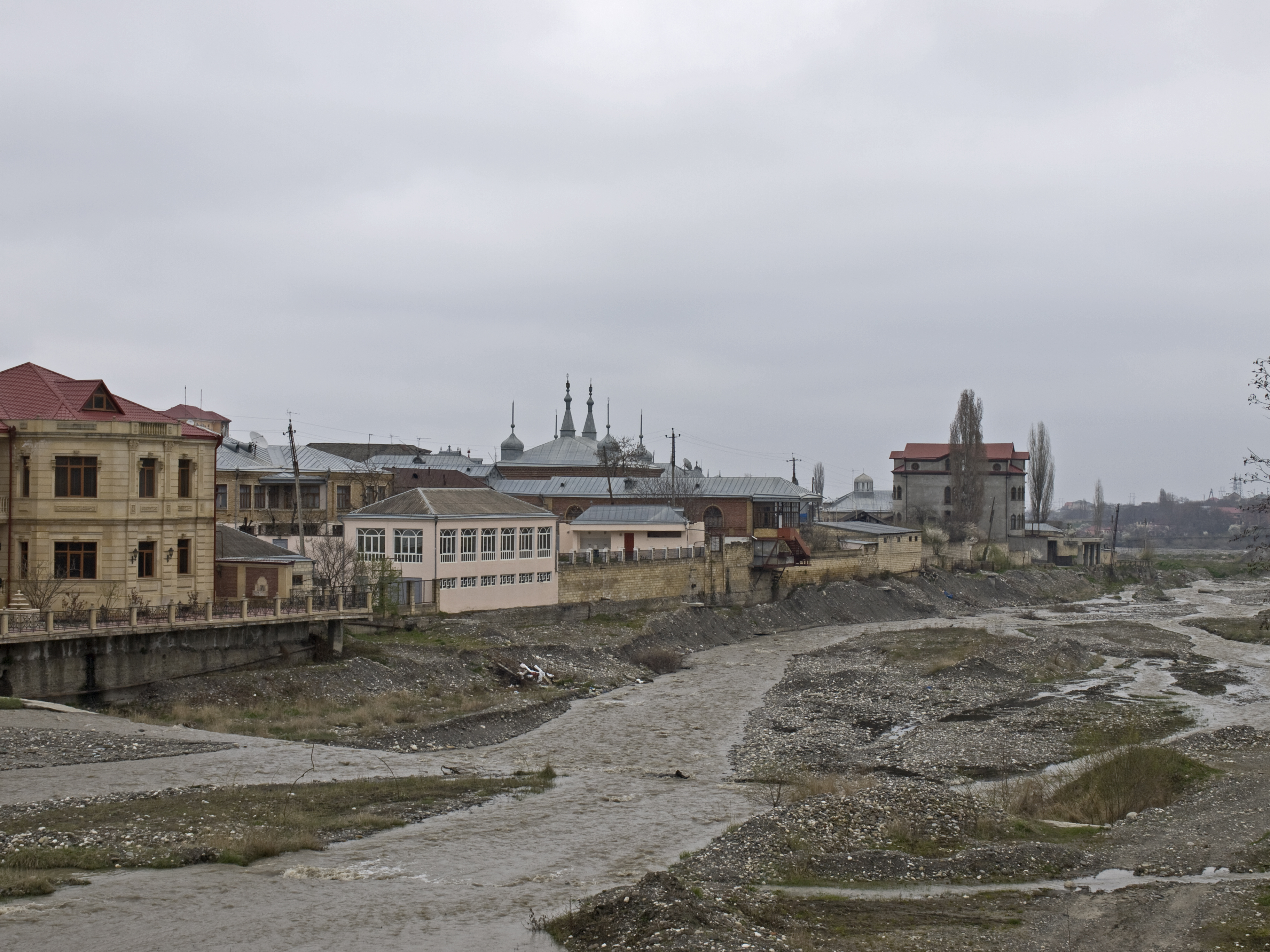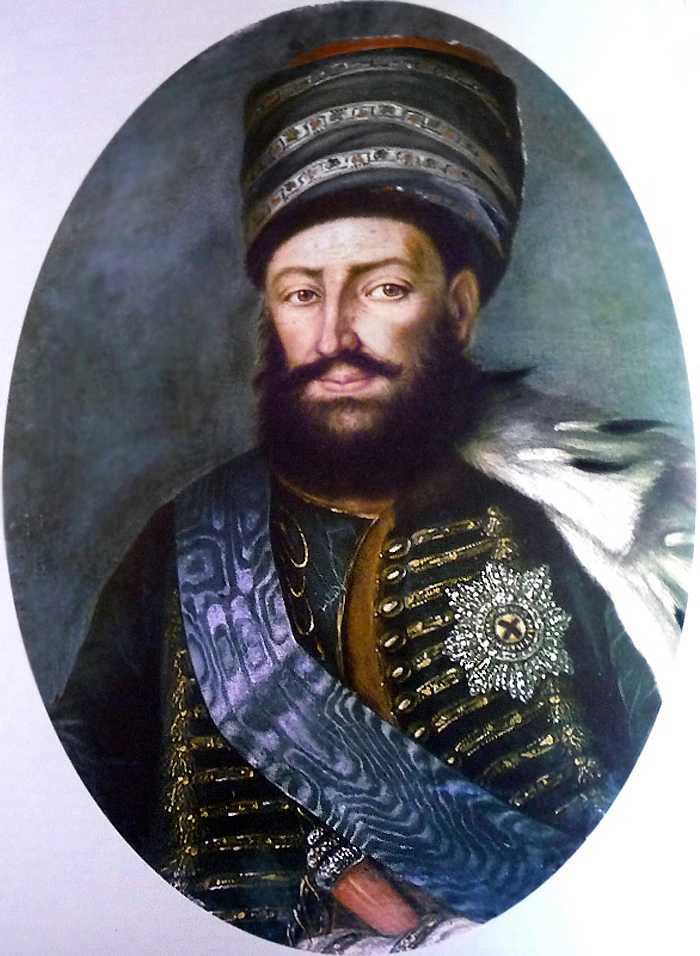|
Qırmızı Qəsəbə
Qırmızı Qəsəbə is a village and municipality in the Quba District of Azerbaijan. As of 2010, it had a population of 3,598, mostly Jews. It is widely believed to be the world's only population centre exclusively made up of Jewish people outside of Israel and the United States, and is likewise considered to be the last surviving . Located across the Qudyal river from the city of Quba, it is the principal settlement of Azerbaijan's Caucasus Jewish population; the most widely spoken language in the village is Judeo-Tat. The names of the municipality in Azerbaijani, Russian, and Hebrew all translate to "Red Town" or "Red Village", supposedly in reference to the red tiles used on the buildings. Other sources attribute the name of Qırmızı Qəsəbə to the protected status that it received during World War II, when its residents were shielded from potential persecution in light of Nazi Germany's invasion of the Soviet Union. History Jews in Quba and Azerbaijan The first J ... [...More Info...] [...Related Items...] OR: [Wikipedia] [Google] [Baidu] |
Municipality
A municipality is usually a single administrative division having municipal corporation, corporate status and powers of self-government or jurisdiction as granted by national and regional laws to which it is subordinate. The term ''municipality'' may also mean the governing body of a given municipality. A municipality is a general-purpose administrative subdivision, as opposed to a special district (United States), special-purpose district. The English language, English word is derived from French language, French , which in turn derives from the Latin language, Latin , based on the word for social contract (), referring originally to the Latin communities that supplied Rome with troops in exchange for their own incorporation into the Roman state (granting Roman citizenship to the inhabitants) while permitting the communities to retain their own local governments (a limited autonomy). A municipality can be any political jurisdiction (area), jurisdiction, from a sovereign state s ... [...More Info...] [...Related Items...] OR: [Wikipedia] [Google] [Baidu] |
Judeo-Tat
Judeo-Tat or Juhuri (, , ) is a Judeo-Persian dialect and the traditional language spoken by the Mountain Jews in the eastern Caucasus Mountains, especially Azerbaijan, parts of Russia and today in Israel. It belongs to the southwestern group of the Iranian division of the Indo-European languages, albeit with heavy influence from Hebrew. The words ''Juhuri'' and ''Juhuro'' translate as "Jewish" and "Jews". The Iranic Tat language is spoken by the Muslim Tats of Azerbaijan, a group to which the Mountain Jews were mistakenly considered to belong during the era of Soviet historiography though the languages probably originated in the same region of the Persian Empire. Judeo-Tat features Semitic elements in all linguistic levels of the language. Uniquely, Judeo-Tat retains the voiced pharyngeal approximant, also known as ayin (ع/ע), a phoneme whose presence is considered to be a hallmark of Semitic languages such as Arabic and no longer found in Modern Hebrew; no neighb ... [...More Info...] [...Related Items...] OR: [Wikipedia] [Google] [Baidu] |
Şuduq
Şuduq (also, Shudug and Shudukh) is a village and municipality in the Quba Rayon of Azerbaijan Azerbaijan, officially the Republic of Azerbaijan, is a Boundaries between the continents, transcontinental and landlocked country at the boundary of West Asia and Eastern Europe. It is a part of the South Caucasus region and is bounded by .... It has a population of 428. References * Populated places in Quba District (Azerbaijan) {{Quba-geo-stub ... [...More Info...] [...Related Items...] OR: [Wikipedia] [Google] [Baidu] |
Uçgün
Uçgün (also, Üçgün and Uchgyun) is a village and municipality in the Quba Rayon of Azerbaijan Azerbaijan, officially the Republic of Azerbaijan, is a Boundaries between the continents, transcontinental and landlocked country at the boundary of West Asia and Eastern Europe. It is a part of the South Caucasus region and is bounded by .... It has a population of 886. References * Populated places in Quba District (Azerbaijan) {{Quba-geo-stub ... [...More Info...] [...Related Items...] OR: [Wikipedia] [Google] [Baidu] |
Qusar District
Qusar District (; ) is one of the 66 Administrative divisions of Azerbaijan, districts of Azerbaijan. It is located in the northeast of the country, in the Guba-Khachmaz Economic Region. The district borders the districts of Quba District (Azerbaijan), Quba, Qabala District, Qabala, Khachmaz District, Khachmaz, and the Russian Republic of Dagestan. Its capital and largest city is Qusar (city), Qusar. As of 2020, the district had a population of 99,000. Toponymy According to the ''Oxford Concise Dictionary of World Place-Names'', the word literally means "man" and derives from Lezgian language, Lezgin ''kus''. There are several theories about the origin of the word "Qusar". One of them is that the word "qusar" comes from the Russian language, meaning "cavalry warrior". "Qusar" regiment was organized in this territory in 1783–1784. The district was probably named "Qusar" after the name of the regiment. There is another theory that the word "qusar" derived from an ancient Turki ... [...More Info...] [...Related Items...] OR: [Wikipedia] [Google] [Baidu] |
Quba Khanate
The Quba Khanate (also spelled Qobbeh; ) was one of the most significant semi-independent khanates that existed from 1747 to 1806, under Iranian suzerainty. It bordered the Caspian Sea to the east, Derbent Khanate to the north, Shaki Khanate to the west, and Baku and Shirvan Khanates to the south. In 1755 it captured Salyan from the Karabakh Khanate. History The khans of Quba were from the Qeytaq tribe, which was divided into two branches, the Majales and the Yengikend. The origin of the tribe is obscure. First attested in the 9th-century, only their chieftain and his family were Muslims, according to the historian al-Masudi (died 956). The chieftain bore the Turkic title of ''Salifan'', as well as the title of ''Kheydaqan-shah''. According to the 17th-century Ottoman historian, Evliya Çelebi (died 1682), the Qeytaq spoke Mongolian, but this was dismissed as a "hoax" by the Iranologist Vladimir Minorsky (died 1966), who demonstrated that Çelebi copied the alleged Mongo ... [...More Info...] [...Related Items...] OR: [Wikipedia] [Google] [Baidu] |
Fatali Khan
Fatali Khan or Fath-Ali Khan of Quba () (1736 – March 29, 1789) was a khan of the Quba Khanate (1758–1789) who also managed to dominate the Derbent, Baku, Talysh and Shirvan Khanates, as well as the Salyan Sultanate during much of his reign. Early years Fatali was born in 1736 in Quba to Husayn Ali Khan of Quba Khanate and Peri Jahan-Bike, daughter of Ahmad Khan, Utsmi of Kaitags. He was related to other Dagestani rulers, such as Umma Khan V, who was his maternal cousin, Amir Hamza, his cousin and brother-in-law, as well as Utsmi of Kaitags, among others. According to the 19th-century military historian Isgandar bey Hajinski (1809–1878), he had no special education and "spent his youth just as sons of other khans, i.e. in idleness." He was sent to subjugate Salyan Sultanate in 1755 or 1756 by his father, a mission he accomplished successfully. His father died in 1758 at the age of 49, leaving the throne to his young son. Reign Just seven days after his father's ... [...More Info...] [...Related Items...] OR: [Wikipedia] [Google] [Baidu] |
Soviet Union
The Union of Soviet Socialist Republics. (USSR), commonly known as the Soviet Union, was a List of former transcontinental countries#Since 1700, transcontinental country that spanned much of Eurasia from 1922 until Dissolution of the Soviet Union, it dissolved in 1991. During its existence, it was the list of countries and dependencies by area, largest country by area, extending across Time in Russia, eleven time zones and sharing Geography of the Soviet Union#Borders and neighbors, borders with twelve countries, and the List of countries and dependencies by population, third-most populous country. An overall successor to the Russian Empire, it was nominally organized as a federal union of Republics of the Soviet Union, national republics, the largest and most populous of which was the Russian SFSR. In practice, Government of the Soviet Union, its government and Economy of the Soviet Union, economy were Soviet-type economic planning, highly centralized. As a one-party state go ... [...More Info...] [...Related Items...] OR: [Wikipedia] [Google] [Baidu] |
Sloboda (settlement)
A sloboda was a type of settlement in the history of Belarus, Russia and Ukraine. The name is derived from the early Slavic word for 'freedom' and may be loosely translated as 'free settlement'."Sloboda" '''' (1890–1906) History In the history of Russia, a ''sloboda'' was a settlement or a town district of people free of the power of s. Often these were settlements of tradesmen and artisans, and were named according to their trade, such as the[...More Info...] [...Related Items...] OR: [Wikipedia] [Google] [Baidu] |
Nader Shah
Nader Shah Afshar (; 6 August 1698 or 22 October 1688 – 20 June 1747) was the founder of the Afsharid dynasty of Iran and one of the most powerful rulers in Iranian history, ruling as shah of Iran (Persia) from 1736 to 1747, when he was assassinated during a rebellion. He fought numerous campaigns throughout the Middle East, the Caucasus, Central Asia, and South Asia, emerging victorious from the battles of Herat, Mihmandust, Murche-Khort, Kirkuk, Yeghevārd, Khyber Pass, Karnal, and Kars. Because of his military genius,The Sword of Persia: Nader Shah, from Tribal Warrior to Conquering Tyrant "Nader commanded the most powerful military force in Asia, if not the world" (quote from publisher's summary) some historians have described him as the '' |
Street In Krasnaya Slovoda
A street is a public thoroughfare in a city, town or village, typically lined with buildings on one or both sides. Streets often include pavements (sidewalks), pedestrian crossings, and sometimes amenities like streetlights or benches. A street can be as simple as a level patch of dirt, but is more often paved with a hard, durable surface such as tarmac, concrete, cobblestone or brick. It can be designed for both social activity and movement. Originally, the word ''street'' simply meant a paved road (). The word ''street'' is still sometimes used informally as a synonym for ''road'', for example in connection with the ancient Watling Street, but city residents and urban planners draw a significant modern distinction: a road's main function is transportation, while streets facilitate public interaction.Dictionary Exam ... [...More Info...] [...Related Items...] OR: [Wikipedia] [Google] [Baidu] |
Synagogue At Qırmızı Qəsəbə
A synagogue, also called a shul or a temple, is a place of worship for Jews and Samaritans. It is a place for prayer (the main sanctuary and sometimes smaller chapels) where Jews attend religious services or special ceremonies such as weddings, bar and bat mitzvahs, choir performances, and children's plays. They often also have rooms for study, social halls, administrative and charitable offices, classrooms for religious and Hebrew studies, and many places to sit and congregate. They often display commemorative, historic, or modern artwork alongside items of Jewish historical significance or history about the synagogue itself. Synagogues are buildings used for Jewish prayer, study, assembly, and reading of the Torah. The Torah (Pentateuch or Five Books of Moses) is traditionally read in its entirety over a period of a year in weekly portions during services, or in some synagogues on a triennial cycle. However, the edifice of a synagogue as such is not essential for holdi ... [...More Info...] [...Related Items...] OR: [Wikipedia] [Google] [Baidu] |




